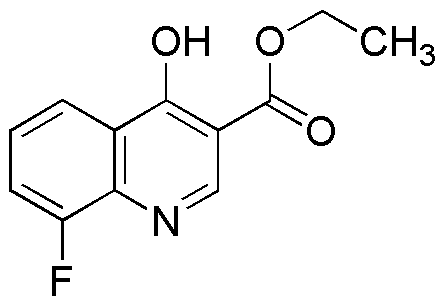Ethyl 8-fluoro-4-hydroxy-3-quinolinecarboxylate is widely utilized in research focused on:
- Pharmaceutical Development: This compound serves as a key intermediate in the synthesis of various pharmaceutical agents, particularly those targeting bacterial infections and cancer, enhancing drug efficacy.
- Antimicrobial Research: Its unique structure contributes to its effectiveness against a range of pathogens, making it valuable in the development of new antimicrobial agents.
- Fluorescent Probes: The compound's fluorescent properties allow it to be used in biological imaging, aiding researchers in visualizing cellular processes in real-time.
- Material Science: It can be incorporated into polymers to create materials with enhanced properties, such as improved thermal stability and UV resistance, beneficial for various industrial applications.
- Biochemical Assays: This chemical is utilized in assays to study enzyme activity and interactions, providing insights that are crucial for drug discovery and development.
General Information
Properties
Safety and Regulations
Applications
Ethyl 8-fluoro-4-hydroxy-3-quinolinecarboxylate is widely utilized in research focused on:
- Pharmaceutical Development: This compound serves as a key intermediate in the synthesis of various pharmaceutical agents, particularly those targeting bacterial infections and cancer, enhancing drug efficacy.
- Antimicrobial Research: Its unique structure contributes to its effectiveness against a range of pathogens, making it valuable in the development of new antimicrobial agents.
- Fluorescent Probes: The compound's fluorescent properties allow it to be used in biological imaging, aiding researchers in visualizing cellular processes in real-time.
- Material Science: It can be incorporated into polymers to create materials with enhanced properties, such as improved thermal stability and UV resistance, beneficial for various industrial applications.
- Biochemical Assays: This chemical is utilized in assays to study enzyme activity and interactions, providing insights that are crucial for drug discovery and development.
Documents
Safety Data Sheets (SDS)
The SDS provides comprehensive safety information on handling, storage, and disposal of the product.
Product Specification (PS)
The PS provides a comprehensive breakdown of the product’s properties, including chemical composition, physical state, purity, and storage requirements. It also details acceptable quality ranges and the product's intended applications.
Certificates of Analysis (COA)
Search for Certificates of Analysis (COA) by entering the products Lot Number. Lot and Batch Numbers can be found on a product’s label following the words ‘Lot’ or ‘Batch’.
Numéro de catalogue
Numéro de lot/série
Certificates Of Origin (COO)
This COO confirms the country where the product was manufactured, and also details the materials and components used in it and whether it is derived from natural, synthetic, or other specific sources. This certificate may be required for customs, trade, and regulatory compliance.
Numéro de catalogue
Numéro de lot/série
Safety Data Sheets (SDS)
The SDS provides comprehensive safety information on handling, storage, and disposal of the product.
DownloadProduct Specification (PS)
The PS provides a comprehensive breakdown of the product’s properties, including chemical composition, physical state, purity, and storage requirements. It also details acceptable quality ranges and the product's intended applications.
DownloadCertificates of Analysis (COA)
Search for Certificates of Analysis (COA) by entering the products Lot Number. Lot and Batch Numbers can be found on a product’s label following the words ‘Lot’ or ‘Batch’.
Numéro de catalogue
Numéro de lot/série
Certificates Of Origin (COO)
This COO confirms the country where the product was manufactured, and also details the materials and components used in it and whether it is derived from natural, synthetic, or other specific sources. This certificate may be required for customs, trade, and regulatory compliance.


